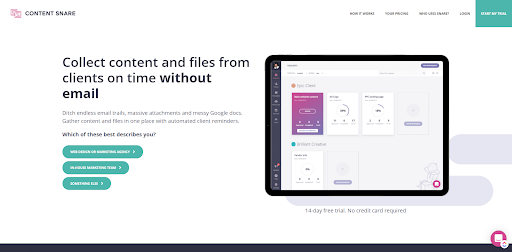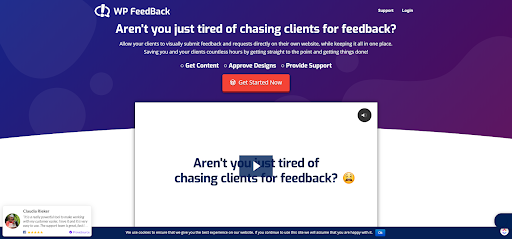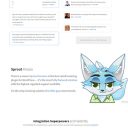If you are like me, you have created websites for clients that have gone quiet while waiting for them to deliver the copy.
I remember one such time. I was managing the project for the agency where I worked. The client had informed us that he would have his wife to write the copy. Turns out his wife had an English degree.
It took over a year to launch get the copy from this client.
Writing for an English degree in college is not the same skill as writing copy for a website. In fact, writing for college papers is not the same skill.
For your website, you want to persuade the reader to take action. There are various copywriting principles you will need to use to make this happen.
This is one of the major reasons that it is hard for most people to write their own website copy.
In spite of this, some clients insist on creating their own website copy, and you have to get the website launched. So, what can you do?
Today we are going to dissect five different ways that you can gather copy from your client for a website project.

Tools for gathering content
In our industry as web developers, particularly WordPress developers, we are fortunate to have a couple of options to help gather content.
Content Snare is a tool that was created by James Rose and Mark Beljaars of Aktura.
The software allows you to create templates that guide clients where to put the content.
The tool acts as a project management tool because you can create follow-ups that can be emailed to clients.
You can, therefore, approve the content or request revisions.
As an agency owner, you can create templates that are reusable for various clients saving you valuable time.
A feature I like is that when you have everything completed, you can download the content in a single zip file.
I am always amazed by how many businesses do not have a repository of their most basic content and information.
You can generate this library of basic content with one click.
One of the newest tools in our space was launched by Vito Peleg and his team called WP Feedback. This tool is unique because it is a plugin that allows your client to interact with your staging website build.
It uses little tabs you that you can place on each area and ask for the content. Further, you can leave instructions.
The good thing about this tool is that all the client has to do is go to the website and start inputting the content.
It eliminates the need for a client to sign up and create an account with another software tool. It is straightforward and very intuitive.
It is a fantastic way to gather content from your clients.
Project Management
One of the things you can do to make gathering content more efficient is to use a Project Manager.
Typically when you work on a project, you already have a Project Manager (PM) on your team to help move the project along. In this case, one of the tasks they would take on is aiding the client in getting their content to the team.
Your client is not an expert in gathering or creating content, so your PM can help them along the way with guidance, tips, and reminders.
GatherContent is a content gathering platform for enterprise-level companies and organizations. One of the features of its platform is Content Project Management.
I’ve worked enough projects with an agency to know that many teams completely turn this over to the client when, in fact, they should manage that process themselves.
Having a person who is in charge of the content gathering process is a great idea to help the client along in the process.
Content Planning Workshop

https://www.pexels.com/photo/people-notes-meeting-team-7095/
Most agencies have an onboarding process. You may even meet with your new client to kick off the event. When I worked for an agency, I only heard about these events, but they were designed to welcome the client, go over important information, and then give them directions for the next steps.
Workshops work really well to get everyone onboard with how to produce content. By involving as many people and key stakeholders as possible in these workshops, you can really underline people’s responsibilities, where they fit into the workflow and make it clear this process won’t happen overnight.
Source: Smashing Magazine

https://www.pexels.com/photo/top-view-photo-of-people-near-wooden-table-3183150/
A content planning workshop can be added to the onboarding process. In this type of workshop, you schedule a time where you go through a checklist of things you need to for the website content.
You don’t want to start the project and three weeks later have the customer be looking for the PNG version of their logo. How many times have they sent that to you in a Word document?
Consider making a worksheet with all the things you need to gather the content. Give it to the client ahead of time so that they will have the necessary items at the meeting.
If you are meeting the client at their office, then they can look for the items during the meeting. The idea is to let them know ahead of time about the things that you will be needing for content.
Have A systematized process
One of the biggest mistakes I have seen agencies make is they simply don’t have a process.
As we noted before, the content is often handed off to the client to complete. The client does not have expertise in creating and gathering content, so this becomes a nightmare.
After all, they are busy running a business.
Content gathering should be owned by the agency. Create a process to gather that content.
You should decide on a tool to use, the types of content you will need every time, the types of files you will need, and the types of content you may need. Create this process in your Project Management tool is a template and use it for every website project.
Remember, you are the expert on the website project, even if you don’t write a single word.
Another thing you might consider is making your agency a content-first company. In this case, you make sure you have all the content upfront before you begin the project.
There is a tremendous amount of strategy that can go into a website project. That strategy informs the direction of the project and the design.
The last thing you want to do is create the design and force the copy to fit into the design.
Content First Design’ is an approach that involves the use of content to define the layout and elements in a design, rather than the other way around. It’s quite common to see placeholder text and images used throughout the prototyping process, and real content only introduced at the very end. The problem here is that dummy content doesn’t capture the context of what designs will be used for, causing issues when the product is used in the wild.
Source: Prototypr
If you notice, the title of the article is about gathering copy, not content.
There is a reason for this. Copy is only part of the website content.
While content is a big hangup, a huge part of that hangup is the copy or copywriting.
This leads me to the next point..

https://www.pexels.com/photo/coffee-notebook-writing-computer-34601/
Partner with a copywriter
Since copywriting is one of the biggest issues, partnering with or hiring a copywriter is a great solution.
There are many copywriters who love writing website copy. After all, every company needs a website, so they need someone to write the copy.
There is nothing worse than your client staring at a blank screen because he or she does not know what to write.
Okay, there is something that is actually worse.
What is worse is a client who hands in the most boring, informational, non-persuasive copy that can ever be included in a website project.
Unless your client is a professional copywriter, he or she will likely do just that. Even if he or she is a copywriter, it is extremely difficult to write about your own business.
It is hard for anyone to write about his or her own business because they are too close to see what is needed. Imagine your client who is not a copywriter trying to write about their business.
Some agencies have decided to use a copywriter on every project because, often, they end up having to rewrite the copy.
Consider making the copywriting an integral part of the process and teaming up with a copywriter.
Wrapping it up
Gathering copy for your website project is a premium task. In fact, the right copywriter can make your client money.
If you want to create more value for your project, position yourself as an expert, and generate more revenue for your agency, make copywriting a significant part of your offering.
Just as you might outsource someone to create a custom plugin or app, using a professional copywriter can be a tremendous value add for your business.
One of the best places you can start is by using the Website Copy Framework to help position yourself as a consultant and expert.
The Website Copy Framework will help your client begin filling in the blanks for the info needed to create a more compelling copy.






Trackbacks/Pingbacks